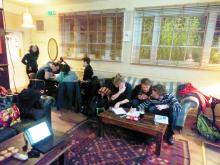
Submitted by Jenny Molloy on Fri, 22/12/2017 - 16:26
Four teams pitted their wits against the Café Synthetique SynBio Pub Quiz on 18 December at the Panton Arms. Congratulations to the winners and we've provided a couple of rounds of questions here so you can see how you would have done!
Congratulations to all those who took part and especially to 'The Four Idiots' who belied their name to triumph with 46 out of a possible 71 marks.
The questions took in a range of obscure scientific facts, anagrams, truly terrible picture puns spelling out famous scientists and a selection of everyday objects under the microscope. Thanks to all those who took part and we hope to see you for Café Synthetique in 2018!

Synthetic Biology
1. What does CRISPR stand for?
A: Clustered Regulatory Interspaced Short Palindromic Repeats
B: Clustered Regulatory Interspaced Small Palindromic Repeats
C: Clustered Regulatory Interspaced Short Protein Repeats
D: Clustered Regulatory Interspaced Small Protein Repeats
2. What percentage of sequenced bacteria are CRISPRS found in?
A: 10%
B: 25%
C: 40%
D: 80%
3. The Food and Drug Administration approved this genetically engineered food for human consumption in 2015:
A: EverGreen Spinach
B: BugmeNot Apples
C: AquAdvantage Salmon
4. In 2016, news broke that researchers had genetically modified mushrooms so that they …
A: Would have higher protein levels
B: Wouldn’t brown when cut
C: Would taste meatier
5. This program aims to use advanced biotechnologies to engineer insects that can protect crops:
A: Bug Safe
B: Insect Allies
C: Bee Safe
6. Gene drives were recently used to address drug resistance in which pathogen?
A: Candida albicans
B: Staphylococcus aureus
C: Clostridium difficile
Discovery of DNA
From the NCBE DNA 50 quiz compiled by Dean Madden
1. What is special about 19–20 Portugal Place, Cambridge (The Golden Helix, the Cricks’ former home)?
A: it has a single helix on the wall outside
B: it has a double helix on the wall outside
C: it has two double helices on the wall outside
2. Why did Jim Watson’s mother try to prevent him from going to Cambridge in 1951?
A: he’d forgotten to take clean sock
B: she thought he should be “taught a lesson"
C: she thought the buildings would be draughty
3. Where was DNA discovered?
A: England
B: Germany
C: Switzerland
4. In Watson and Crick’s 1953 letter to Nature, who drew the diagram of the double helix?
A: Odile Crick, Francis Crick’s wife
B: Elizabeth Watson, Jim Watson’s sister
C: Tony Broad, a Cavendish laboratory technician
5. What organism did the DNA samples used by Rosalind Franklin come from?
A: Escherichia coli
B: Calf thymus
C: Salmon sperm
6. What did Rosalind Franklin ask for for her 29th birthday in 1949?
A: a sewing machine
B: a pair of hiking boots
C: a subscription to a scientific journal

